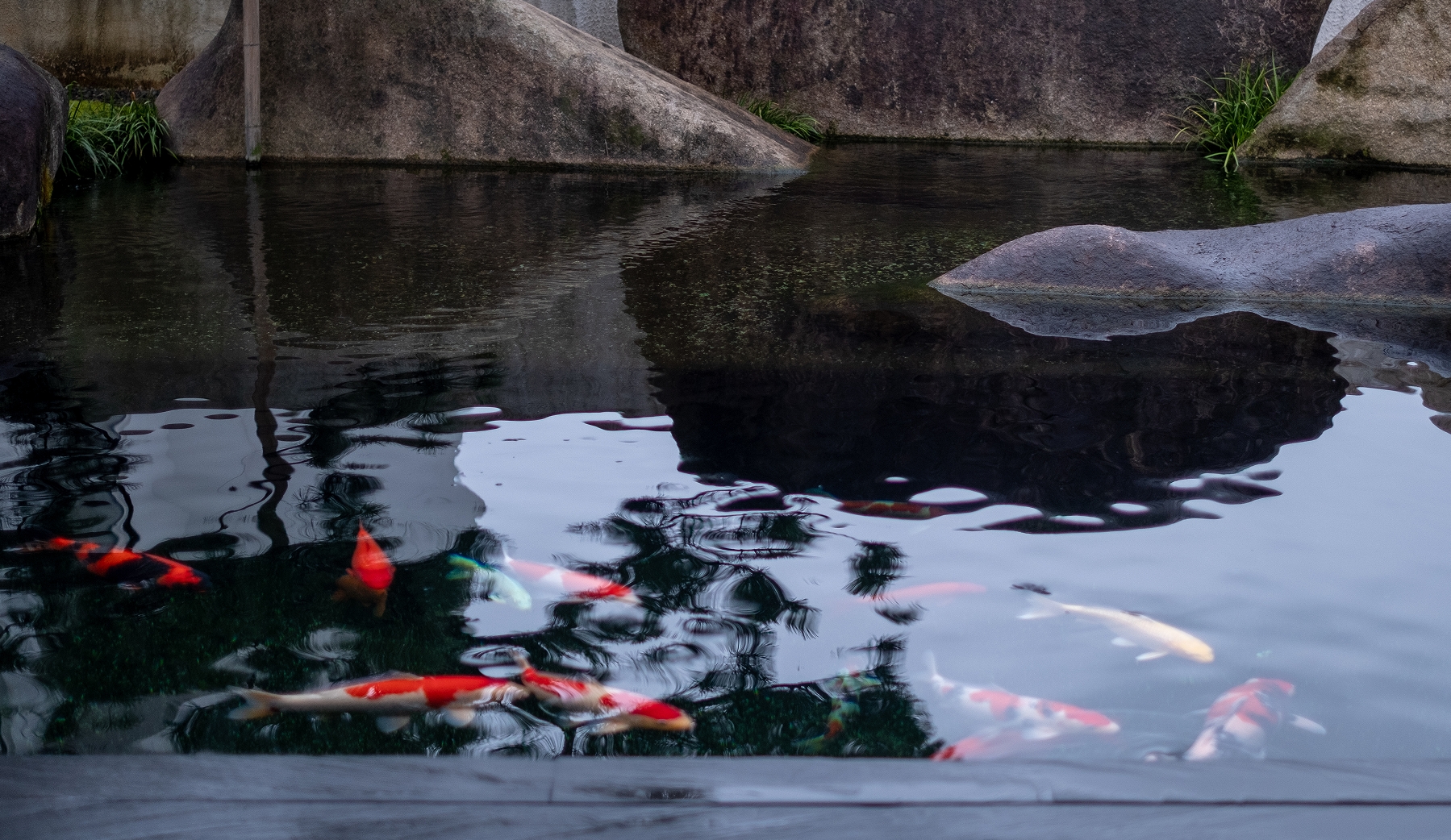
Imagine turning your outdoor area or backyard into an immense peaceful and beautiful pond where beautiful koi species create their graceful movements and reflect their vibrant colours. Building a koi pond is not just a simple project, but by reading this article, everyone will understand the complex point in an easier way to make your pond. Let’s read!
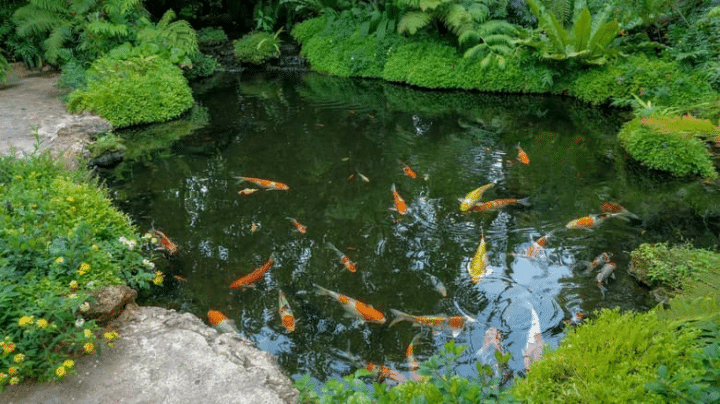
A koi pond can greatly improve the ambiance of your outdoor area and create an attractive point that draws attention and admiration. The calming sound of running water and the pleasant movements of koi fish reduce the stress and give relaxation to the owner of the pond. As demand for koi fish is increasing, it can be the best investment and income source.
Koi Pond requires regular upkeep for maintenance and longevity. A healthy pond ecosystem can provide long-lasting enjoyment and depends on design, seasonal maintenance, regular monitoring, proper filtration systems, and water quality control.
You need to consider a few important factors before starting construction on your koi pond. The right location is essential; To enhance koi coloration, ensure your fish pond is positioned in a well-lit area. Additionally, select a terrain that minimizes the risk of mudslides or river back-ups, as these can introduce significant sediment and impurities, adversely affecting water quality and the pond’s ecosystem.
You need to plan the quantity and size of koi according to the size and depth of the pond because it causes overcrowding. Additionally, Avoid the water seepage or instability in the pond structure. A well-planned koi pond project is essential for success. Developing a blueprint that covers the designing, landscaping features, filter scheme will be helpful and prevent additional expensive mistakes. By putting a brief plan in place, you can check that every feature of your koi pond is carefully planned to give your fish a healthy and long-lasting habitat.
Space and requirements are two major elements that we need to keep in mind while creating the koi pond for koi growth.
We classify fish ponds based on their water volume: small ponds hold 30 tons or less, medium ponds hold 30-80 tons, and large ponds hold more than 80 tons. The size of the pond is primarily determined by the size of the koi and the number of fish being bred. Ideally, the depth of the pond should be adjusted based on temperature: in areas where temperatures range from -20 to -10 degrees, the pond depth should be 2.2 meters; from -10 to 0 degrees, the depth should be 2 meters; and in areas above 0 degrees, the depth should be between 1.5 and 1.8 meters. Additionally, it is beneficial to include a shallow water area within the pond.
With the right equipment, tools and technology, koi ponds will run smoothly, and koi species will be healthy and happy. Following are the essential tools checklist
The shape of the pond and water features play a significant role in aesthetic appeal. Natural or free forms give organic looks, but oval, hexagon, square, circular, and rectangular shapes offer more modern looks. The shape of the pond should be planned in a way that provides optimal water circulation, prevents dead zones, and fosters the growth of a thriving, oxygen-rich ecosystem. To add the water features, waterfalls/fountains are the most reliable option that can elevate its look. It offers visual and practical benefits such as better water circulation and aeration. Lighting is another alternative to enhance the ambiance of the pond.
Natural rocks, woods, and stones are best for attractive landscaping. They mimic the original water bodies. Instead of using sharp angles or corners, use organic shapes or gently curved edges.
There are a few crucial procedures in the excavation and construction process that will make your Koi pond come to life.
Foundation Excavation: Ensure the foundation is even and level to provide a stable base for the pond structure.
Bedding Preparation: Create a horizontal working surface by casting a 5-10 centimeter layer of concrete over the entire foundation.
Pipe Installation: Install the necessary pipes, calculating the number based on 4-5 times the total water volume of the pond to ensure adequate circulation and filtration.
Reinforcement Securing: Use steel bars and wires to secure the pipes and reinforcements, preventing any shifting or angle changes during concrete pouring.
Concrete Pouring: Utilize one-piece concrete for constructing the fish pond to ensure a robust and durable structure.
Filter Bin Construction: Build at least 4-5 filter bins to maintain optimal water quality and filtration efficiency.
Waterproofing: Apply polymer cement waterproof coatings or waterproof membranes to ensure the pond is watertight and protected from leaks.
This critical stage ensures that your pond is structurally sound and provides a stable base for the landscapes, creating a healthy and vibrant koi environment.
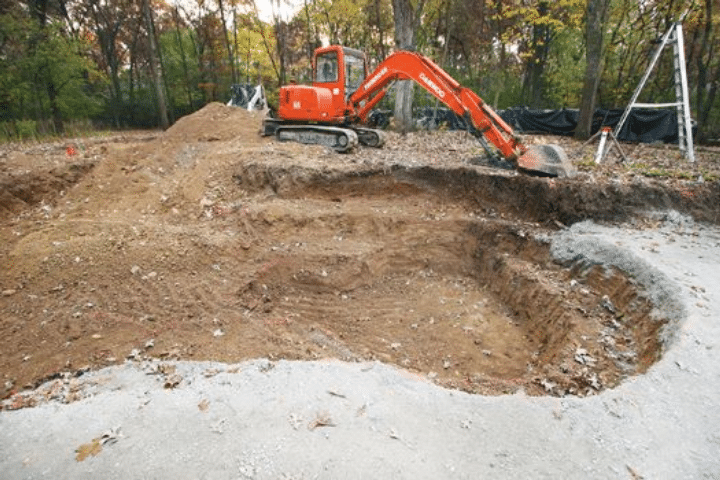
Advanced filters are an integral part of any pond to keep the internal environment clean and healthy. The filtration system comprises four key chambers: a physical filtration chamber, a biochemical filtration chamber, an ecological improvement chamber, and a sterilization chamber. Generally, a larger filtration ratio is more effective. For ponds under 30 tons, a filtration ratio of 4:1 is recommended, while ponds over 30 tons should have a ratio of 5:1.
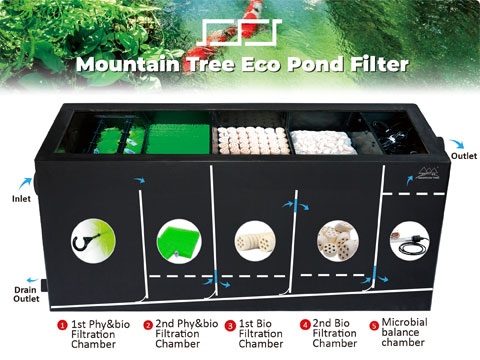
The primary role of physical filtration is to initially purify the water by removing larger particles of impurities, serving as the first line of defense in the fish pond filtration system. This process uses brushes and other filter materials to effectively intercept suspended matter in the water, such as fish feces, residual feed, withered plants, and other visible pollutants. By reducing the content of suspended solids and turbidity, physical filtration helps to improve water transparency and reduces the burden on subsequent biological filtration stages.
Biological filters keep the ponds clean through nitrification and denitrification processes. Nitrification is responsible for converting the toxic waste of fish nitrites and nitrates with the help of beneficial bacteria. Whereas, denitrification further breaks down the nitrates into nitrogen gasses which helps to prevent the production of algae blooms in water. Therefore, we can create optimal growth conditions for beneficial bacteria and improve the biochemical filtration efficiency by using filter media with larger surface area such as bacteria house, ceramic rings… Sufficient oxygen level, stable pH, and water temperature.
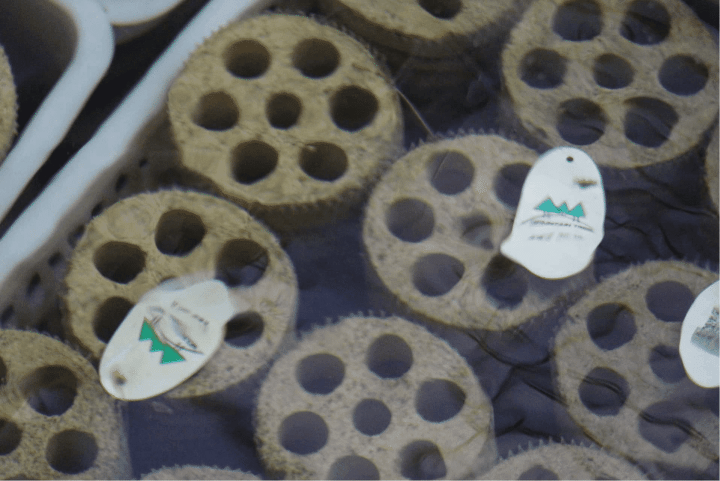
A good pump is necessary for the regulation of water in ponds.The power of the pump should be based on the capacity of the fish pond, and it is generally recommended that the flow of the pump for large, medium and small fish ponds be 1, 1.5 and 2 times the amount of water in the pond, respectively
Uv-resistant pipes and fittings are crucial because they prevent degradation, cracks, and leaks. Furthermore, this reliable material has resistance against the harsh weather conditions and pressure.
For proper plumbing, make sure it is securely tightened and use the sealants to avoid the leakage. In colder climates, always bury the pipes below the frost lines which protect it from freeze damage.
Ideally, the dissolved oxygen content in the fish pond should be between 6-8 mg/L. This is a crucial survival indicator for koi, algae, and other organisms. Insufficient dissolved oxygen can lead to the death of aquatic life and significantly impact water quality.
Always select the air diffusor according to the size of the pond to ensure the distribution of oxygen.For smaller ponds, it is recommended to install the oxygen pump in the middle and upper reaches of the water cycle. Larger ponds, however, will require multiple oxygen pumps to adequately meet the dissolved oxygen demand.
Self-draining systems involve bottom drains, skimmers, and overflow pipes for the accumulation and removal of debris. Install the bottom drain at the depth of the pond for the taking away of settled waste and flushing the debris automatically. Skimmers are placed along the surface of the ponds to capture the floating waste material while overflow pipes control the water flow in heavy rains. Moreover, utilising the ball- valve, fittings, and gravity-fed filtration system increases the water movement with more maintenance ease.
In cold climates, heat exchangers are the main necessity to maintain the optimal water conditions of koi ponds. Heat exchangers have significant solutions to regulate the water temperature within the range. These devices transfer the external heat from solar panels and gas boilers into the pond water without making direct contact with fluids. These systems also avoid harmful fluctuation. To enhance the work abilities, it is essential to choose an appropriate-sized heat exchanger that creates a comfortable environment for koi.
Frozen pipes can cause damage to the pump and water circulation can be stopped. To winterize the plumbing system, drain all the pumps and pipes that lead to bursting and cracking. Use the wet/dry vacuums for drainage. Another strategy is to open the bottom drain partially and allow the water to go out which will prevent freezing. Additionally, installing the de-icer and heater in a pond and covering the pond with a weatherproof sheet minimises the heat loss.
In cold weather, different insulation and drainage techniques can safeguard the pond from heavy damage. It is recommended to use heat tape, foam pipe insulation and self-regulating heating wires to maintain the temperature. For optimal protection, all parts, joints, and bents should be fully covered. Drainage is equally important as the insulation. Use the air compressor, vacuums for the drainage procedure. A combination of insulation and drainage techniques can be helpful to stabilise the water according to the required environments.
When all structural aspects are completed, fill the pond carefully to bring life to the pond.
Before filling the water ensure that all filtration and plumbing systems are installed at their right places and to be able to function. Fill the pond slowly and check if any adjustments are needed. The most important things are the dechlorination of water, acclimation of fish, and adjusting the water parameters before introducing the koi species in the pond. Dechlorination can be done naturally by allowing the water to stay 24 hrs- 48 hrs.
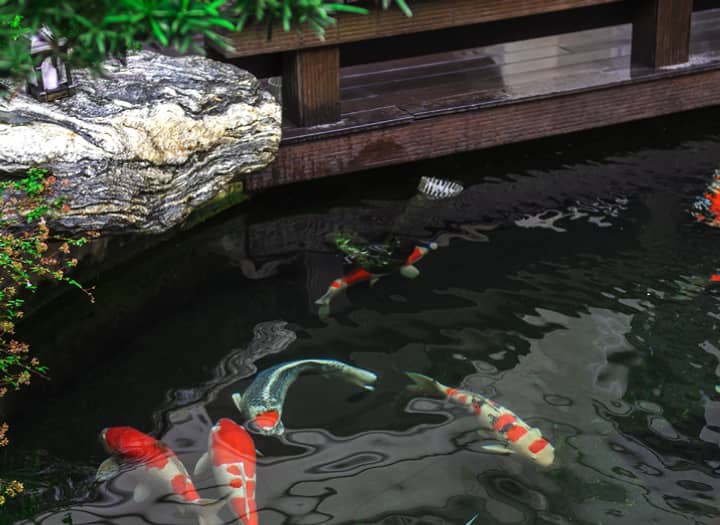
Uneaten food, suspended algae, and fish waste can result in cloudy water that is dangerous for the koi fish. To solve this problem, improving the efficiency of mechanical filters to remove the particles and water changes on a daily basis can also be helpful.
Algae blooms are produced in ponds due to the abundance of nutrients like phosphorus and nitrogen, sun exposure, and warm temperatures. Managing the fish feeding, removing the decaying material, and reducing the nutrient levels are the solutions to algae blooms. Moreover, Uv clarifiers can destroy the algae cells in pond water.
Electrical system failures can pose serious concerns such as electrocution and equipment damage. Regular safety check ups are compulsory to make sure all electrical parts such as heaters, filters, pumps and lights are working in safe condition. For the protection from electrical shocks, use the ground-fault circuit interrupters. Make sure all connections are water and weatherproof.
Keep an eye on water parameters such as pH, Nitrate and ammonia. Higher and lower levels from the required range can cause instability in the pond. Ammonia and nitrate are toxic, their range should be zero. Use the parameter adjuster to check and adjust the water balance. Water changes and overfeeding can also minimise ammonia.
Building and maintaining the koi ponds is an interesting endeavour that has different steps to bring the aquatic life in it. Key steps include the high-quality material for the construction, the right place for a proper thriving environment, effective filtration, aeration, and plumbing process. Managing the water parameters on a daily basis is also a crucial step. Every stage, from initial to end, plays a part to make a healthy and functional habitat for koi. Koi owners enjoy this journey with creative decorative ideas for ponds. It is an amazing experience and satisfaction for pond owners not just for building a pond, but also for watching the koi species thriving in a calm and peaceful environment.
Leave a Reply